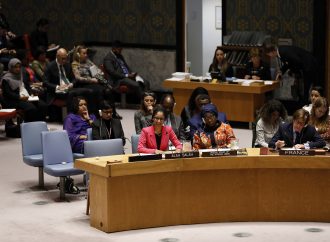On January 20, 2025, one of Donald Trump’s first executive orders was to withdraw the United States from the WHO (World Health Organization). In 1975, the Republican Gerald Ford decided to leave the ILO (International Labour Organization). The Reagan administration withdrew from UNESCO (United Nations Educational, Scientific and Cultural Organization) in 1983. In both cases, the argument given was that the organization had become “politicized”. In Ford’s case, under the influence of communist countries and in Reagan’s case by Third World countries. Like his predecessors, Trump justified the withdrawal of the WHO by “the inability to demonstrate independence from the undue political influence of WHO member states.” Since the multilateral system relies on the contributions and votes of member countries, the wording of the executive order may seem strange, but in reality, the “undue political influence of WHO member states” refers to China.
The growing influence of China in international organizations, reflecting its new position as a great power, is undeniable. Given that the contributions of member states to the UN (United Nations) are calculated according to their GDP (Gross domestic product), the Chinese government became the second largest regular financial contributor to the UN in 2019 (about 15%). In the specific case of the WHO, these regular contributions represent only 20% of the budget, while 80% is covered by voluntary contributions from states or philanthropic foundations. The Chinese make only a small contribution to this voluntary effort, while the United States and major American foundations finance the majority of the organization’s budget. At the same time, Dr. Margaret Chan, a Chinese-Canadian physician, served as Director-General from 2006 to 2017, and Dr. Ren Minghui served as Assistant Director-General for HIV/AIDS, Tuberculosis, Malaria and Neglected Tropical Diseases from 2016 to 2022.
The WHO is not an anomaly. The Food and Agriculture Organization (FAO) has been led by China’s Qu Dongyu since 2019. Ciyong Zou is the deputy director-general of the United Nations Industrial Development Organization (UNIDO), which was headed by another Chinese national, Li Yong, from 2013 to 2021. Several technical organizations, such as the International Telecommunication Union (ITU) and the International Civil Aviation Organization (ICAO), have also been led by Chinese nationals. US Nationals have also directed UN agencies (never the WHO), as was the case with David Morse, Director-General of the ILO between 1948 and 1970, or currently, Amy Pope at the International Office for Migration (IOM). In both cases, however, these directors found themselves at odds with the policies of their own governments, while one of the goals of the Chinese nationals appears to be to help the Chinese government use these agencies to establish its political influence and economic interests around the world in support of its Belt and Road Initiative.
However, we must remember two things. First, Republican administrations of the United States have not refrained from using UN forums to promote their own interests. Moreover, they have not always respected the independence of UN officials who must take an oath to put the interests of the organization they represent above those of their own government. During the McCarthy era, the FBI (Federal Bureau of Investigation) conducted a veritable witch hunt among U.S. international officials. The Secretary-General of the United Nations, the Norwegian Trygve Lie, agreed to have nine permanent officials dismissed in 1952. Some twenty UNESCO officials were harassed, and in 1954 seven of them were dismissed with the approval of the American Director General, Luther Evans. The sociologist and physician Milton I. Roemer, a public health specialist and medical advisor to the WHO in Geneva, was deprived of his passport and had to flee to Canada.
On the other hand, China’s influence on UN agencies, and on the WHO in particular, is also rooted in the way this country has positioned itself internationally as a leader of the underdeveloped world, defending a health model more suited to poor countries. Since 1963, the Chinese government has sent medical teams to many African countries and implemented a training program. The elites of these countries were seduced by the advantages of a health care system that was able to provide care to a large rural population at a lower cost. This Chinese way of providing health care “officially” entered the Western world in 1971, when the first delegation of U.S. doctors was invited by the Chinese Medical Association. They saw it as a source of inspiration for public medicine in the United States as well as in poor countries. This positive reception inspired the 1972 documentary film made by Stanford University researchers: “Barefoot Doctors in Rural China”. A new model was born. The WHO, under the leadership of its Director-General, the Dane Halfdan Mahler, was instrumental in disseminating it. In 1973, the final declaration of the Alma Ata Conference on Primary Health Care – although boycotted by China because it was held in the USSR – emphasized the need to develop medicine accessible to all, and to promote prevention in public health centers by combining local know-how. This model was far removed from the approach of the privatized and curative American health system and was not supported by US representatives. It has nevertheless always been at the foundation of the WHO’s mandate, whose 1946 Constitution states: “The health of all peoples is fundamental to the attainment of peace and security” and “Unequal development in different countries in the promotion of health and the control of disease especially communicable diseases, is a common danger”.
It was in this spirit that the Chinese national Margaret Chan, in her inaugural speech in 2006, proclaimed her commitment to “improving the health of the people of Africa and the health of women” and “of vulnerable populations”. It is also the spirit with which the current director of the WHO, the Ethiopian Tedros Adhanom Ghebreyesusin, has said he wanted to fight the COVID 19 pandemic.
The WHO’s failed actions at the beginning of the pandemic are the second reason given for the withdrawal in the executive order: “Because of the organization’s mishandling of the COVID 19 pandemic.” With each new epidemic crisis, the WHO is criticized for not acting quickly enough or, on the contrary, for sounding the alarm too early. In the case of COVID, it was accused of following the Chinese government’s statements too closely. However, the WHO fulfilled its epidemiological surveillance role, disseminated models of good practice that were then generalized, and, in particular, in partnership with Gavi (the Vaccine Alliance), promoted the distribution of vaccines to the poorest countries (1.8 billion doses) and facilitated the exchange of knowledge and technology.
With a reduced budget and staff – barely more than the Ministry of Health of an average country like France – the WHO does not have the resources to implement a global health policy that is actually outside its remit. However, like all UN agencies, the WHO has fulfilled the role assigned to it by its Member States: to sound the alarm, coordinate responses, provide international expertise available to all, and assist the most vulnerable populations to protect the health of all, including that of US citizens.









